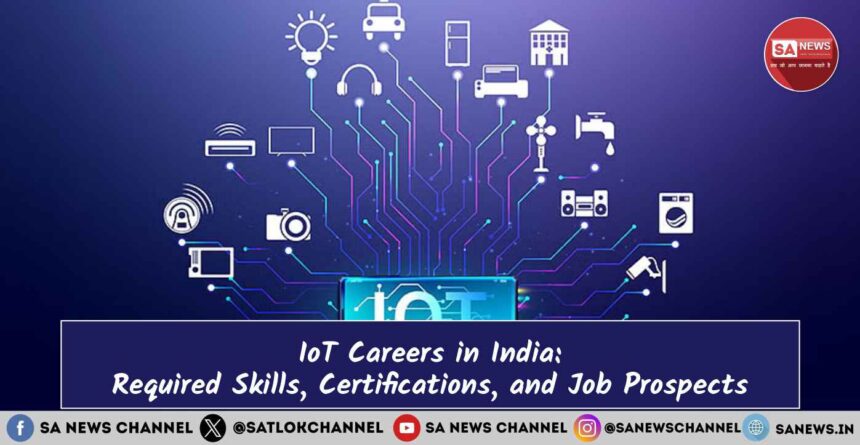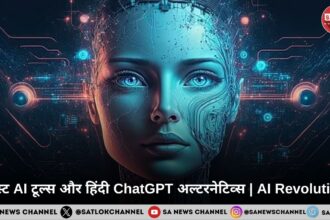“If you think that the internet has changed your life, think again. The Internet of Things is about to change it all over again!” – Brendan O’Brien
The statement might sound outrageous, but it’s not far from reality. By 2030, the world could see 30 to 40 billion devices interconnected, transforming our perspectives on privacy, security, and operational efficiency. IoT technology is silently altering the way we live, from smart homes to autonomous vehicles. Imagine a coffee machine brewing the perfect cup exactly when you need it, or a car predicting traffic patterns before your journey begins. This is the reality of IoT—a world where the hidden web weaves itself seamlessly into daily life.
- Introduction to the Internet of Things (IoT)
- History of IoT
- How IoT Works
- Global IoT Market Overview: Setting the Stage
- India’s Role in the Global IoT Market
- Identifying Gaps: Sources for India-Specific Data
- Educational Pathways for IoT
- Alternative Path to IoT Career
- Beginner-Friendly Books on IoT
- Best Courses for IoT
- Job Opportunities in IoT
- Unique IoT Project Ideas
- Conclusion
- From IoT to True Fulfillment
- Connect With Us on the Following Social Media Platforms
Introduction to the Internet of Things (IoT)
The Internet of Things (IoT) refers to a network of physical objects—devices, vehicles, appliances, and other items—that are embedded with sensors, software, and connectivity to collect and exchange data with minimal human intervention. These interconnected devices communicate over the internet, enabling real-time monitoring, automation, and intelligent decision-making.
IoT has rapidly integrated into various aspects of daily life, from smart homes and wearable health trackers to industrial automation and connected cities. By connecting devices to the internet, IoT enhances efficiency, convenience, and security in numerous sectors, transforming how we live, work, and interact with our environment.
History of IoT
The idea behind IoT started taking shape as early as the 1960s and 1970s, where the development of ARPANET (the precursor to the internet) showed the potential for connected networks. During the 1980s, research on RFID (Radio Frequency Identification) and other sensors paved the way for IoT. One notable example was a modified Coca-Cola machine at Carnegie Mellon University in 1982. It became the first connected appliance that could report its inventory and temperature over the internet, showing early signs of how machines could interact with each other without human intervention.
Also Read: A New Era of Data Protection: India’s Groundbreaking Legislation of 2024
IoT began to gain serious momentum in the 1990s. In 1999, Kevin Ashton popularized the term “Internet of Things” during his work on RFID technology for supply chain enhancement at MIT.
Table: Timeline of IoT Evolution
| Year | Event |
| 1982 | First internet-connected device: the Coke machine at CMU |
| 1999 | Kevin Ashton introduces the term “Internet of Things |
| 2008 | IoT defined as a system of connected devices globally |
| 2011 | IPv6 deployed, supporting a vast number of connected devices |
| 2014 | Consumer IoT takes off with the introduction of smart homes |
| 2020 | 5G networks enable more efficient and faster IoT solutions |
How IoT Works
To understand how IoT works, we need to know some basic Components of an IoT System
1. Sensors/Devices: Sensors are the starting point of any IoT system. They are responsible for collecting data from the environment. This data could be anything, such as temperature, motion, humidity, or even a video feed. Devices like wearables, smart thermostats, and industrial machines often have built-in sensors. The quality and type of data collected depend on the specific application.
2. Connectivity: Once data is collected, it needs a way to be transmitted to a central processing unit. IoT devices use different communication methods to share this data, such as Wi-Fi, Bluetooth, cellular networks, or low-power wide-area networks (LPWAN). Connectivity is critical for allowing devices to communicate over long or short distances efficiently.
3. Data Processing: After data is transmitted, it is sent to a central system, typically cloud-based, where it is processed. This processing could involve analyzing the data in real time or storing it for future use. For example, a smart thermostat might process temperature data to decide when to turn on the heating.
4. User Interface: Finally, users need a way to interact with the system. This interface could be a mobile app, a web dashboard, or even automated actions. The user interface enables monitoring and control of IoT devices remotely.
Global IoT Market Overview: Setting the Stage
The reports deliver abundant statistics on the global IoT landscape, which help in framing India’s expected trajectory within the broader global framework:
- Market Value: Predictions indicate that the global IoT market is set to experience tremendous expansion, with an anticipated valuation of $5,332.3 billion by 2032. This growth reflects a solid compound annual growth rate (CAGR) of 21.3% from 2024 to 2032. In parallel, another source estimates the market’s progression from USD 64.8 billion in 2024 to USD 153.2 billion by 2029, with a CAGR of 18.8%.
Image Credit : IoT Analytics
- IoT Devices: The global count of connected IoT devices is expected to rise considerably. By the close of 2024, projections show the number of connected devices reaching 18.8 billion, reflecting a 13% increase over the 16.6 billion recorded at the end of 2023. Longer-term estimates suggest continued growth, potentially reaching 40 billion connected devices by 2030.
- Cellular IoT Networks: Cellular connections for IoT, including technologies such as 2G, 3G, 4G, 5G, LTE-M, and NB-IoT, comprise a significant portion of the global IoT infrastructure. At present, they make up about 21% of all IoT connections, and their expansion rate is expected to surpass the overall growth rate of IoT connections, underscoring the importance of cellular technology in this ecosystem.
India’s Role in the Global IoT Market
The Asia-Pacific region, which includes India, is projected to dominate the IoT sector, driven by several factors:
- Technological Growth: The region is witnessing continuous advancements in cutting-edge technologies, which are key drivers of IoT market growth.
- Government Support: India’s government plays a critical role in promoting the IoT industry through initiatives like “Digital India” and the “Smart Cities Mission.” These programs encourage IoT adoption across multiple sectors, and venture capital-backed IoT startups are receiving various forms of government incentives, accelerating industry growth.
- Industrial Demand: As industries in the Asia-Pacific region, including India, undergo digital transformation, the need for IoT solutions rises. This demand is further strengthened by the pursuit of higher efficiency, improved productivity, and better data-driven decision-making processes.
The references offer specific observations that shine light on the dynamics shaping India’s IoT market:
- Smart City Projects: The growing implementation of smart city projects across India acts as a significant driver of IoT adoption. These projects involve integrating technologies like smart transportation, smart grids, and interconnected infrastructures, all of which rely heavily on IoT systems. This generates a strong demand for various IoT-based solutions within India.
- Sector-Specific Usage: The healthcare and agriculture sectors in India are increasingly embracing IoT technologies. This trend is fueled by the need for solutions such as remote patient monitoring, precision agriculture, and streamlined supply chain operations.
Identifying Gaps: Sources for India-Specific Data
To gather more detailed data specific to India’s IoT market, additional sources should be explored:
- Industry Research Firms: Market research organizations like IDC, Gartner, and NASSCOM frequently publish detailed reports on India’s technology sector, including insights into IoT trends. These reports often contain precise information regarding market size, growth, and key factors shaping the industry.
- Government Reports: Agencies such as India’s Ministry of Electronics and Information Technology (MeitY) play an essential role in shaping the digital environment. Investigating reports and datasets provided by MeitY and other government bodies may yield valuable insights into IoT statistics.
- Industry Groups: Associations such as the Internet and Mobile Association of India (IAMAI) and the Confederation of Indian Industry (CII) actively engage with the IoT sector. Their publications and reports may contain useful industry-specific data and perspectives.
Educational Pathways for IoT
Bachelor’s Programs
Several leading institutions in India offer undergraduate courses related to IoT:
- Vellore Institute of Technology (VIT), Vellore: Offers B.Tech in Computer Science with IoT specialization. VIT ranks high in NIRF rankings and provides a strong foundation in IoT.
- SRM Institute of Science and Technology, Chennai: Known for its engineering programs and offering degrees with IoT focus at both undergraduate and postgraduate levels.
- Sathyabama Institute of Science and Technology, Chennai: Provides BTech in Instrumentation Engineering with IoT.
- Osmania University, Hyderabad: Offers IoT-focused courses at lower fees, making it accessible for more students.
- Kerala University: BSc programs in IoT are available, with merit-based admissions.
Admissions to most programs are through entrance exams like JEE Main, JEE Advanced, UPSEE, and MHT CET.
Master’s Programs
For those seeking to deepen their knowledge, these top-tier institutes offer IoT-related postgraduate programs:
- Vellore Institute of Technology (VIT), Vellore: Master’s Program in Internet of Things (IoT) and Sensor Technologies.
- Manipal Academy of Higher Education (MAHE), Manipal: M.E in IoT.
- Amrita Vishwa Vidyapeetham, Coimbatore: MCA with IoT specialization.
- Pondicherry University: MTech with IoT integration.
Doctorate Programs
Some institutions offer Ph.D. programs in IoT, including IITs and NITs, where you can engage in advanced research in IoT fields like wireless sensor networks, smart cities, and healthcare applications.
Alternative Path to IoT Career
For students unable to get admission to specialized IoT programs or universities, here are some alternative paths to entering the IoT field:
1. Self-Learning and Online Certifications
● Key Components: Familiarize yourself with the basic components of IoT systems, including sensors, actuators, connectivity, and data processing.
● Learn Programming: Begin by mastering programming languages used in IoT development like Python, JavaScript, C, and C++.
● Hardware Platforms: Gain hands-on experience with affordable hardware platforms like Arduino or Raspberry Pi, which have large online communities and resources.
● Build Simple Projects: Start with small projects, such as controlling an LED light or reading temperature data from a sensor. There are many online tutorials available.
● Join IoT Communities: Engage in IoT-focused forums like Hackster.io and Arduino to connect with developers, access projects, and receive feedback. Join forums like Reddit or Stack Overflow to ask questions and learn from others.
● Follow IoT Blogs and Podcasts: Keep up with the latest trends and technologies in IoT by following blogs, podcasts, and industry news.
● Open Source Contributions: Contribute to IoT-related projects on GitHub, helping build a portfolio to show potential employers.
2. Key Skills for IoT
Skills Needed for IoT Career :
● Programming: Python, C/C++, JavaScript, Java, Go.
● Networking: TCP/IP, MQTT, CoAP, Zigbee, LoRa, Bluetooth.
● Embedded Systems: Microcontrollers such as Arduino, Raspberry Pi, ESP8266 and basics of sensors and actuators.
● Soft Skills: Problem-solving, collaboration, communication.
Additional Advanced skills for Professional Growth :
● Cloud Platforms: AWS IoT, Microsoft Azure IoT, Google Cloud IoT.
● Data Management: SQL, NoSQL (MongoDB), big data tools (Kafka, Hadoop).
● Cybersecurity: Encryption, secure communication, risk management, compliance (GDPR, HIPAA).
● AI and Machine Learning: Data analysis, AI-based automation.
3. Relevant Certifications for IoT
● “CCNA” – Networking basics and IoT communication.
● “AWS Certified Solutions Architect” – AWS IoT cloud solutions.
● “Microsoft Azure IoT Developer” – IoT on Azure platform.
● “CIoT Practitioner (CertNexus)” – Broad IoT fundamentals.
● “Google Cloud IoT Developer”– Google Cloud IoT services.
● “CompTIA IoT+” – IoT frameworks, protocols, security.
● “Certified Embedded Systems Engineer (CESE)” – Embedded system design.
● “CISSP/CEH”– IoT security, penetration testing.
This ensures you gain the core knowledge and certification needed to excel in IoT.
3. Focus on Internships
Companies such as Infosys, TCS, and Wipro often offer IoT-focused internships. Even without a specialized IoT degree, internships can provide the practical exposure needed to build IoT skills. Platforms such as Internshala and LinkedIn often provide internship opportunities.
3. Related Fields
If direct IoT courses aren’t accessible, consider pursuing adjacent fields such as Embedded Systems, Networking, or Cloud Computing. Many of these fields overlap with IoT, and learning skills in these areas can transition into IoT roles. Gaining skills in AWS IoT or Google Cloud IoT can open up more job opportunities in IoT cloud-based services.
4. Freelancing or Personal Projects
Platforms like Upwork and Fiverr can be great avenues to start freelancing on IoT projects. Begin by creating small personal projects like smart home automation systems, document your work on a website, and showcase these projects to potential clients or employers.
Beginner-Friendly Books on IoT
- “Getting Started with the Internet of Things” by Cuno Pfister: This is a simple guide for newcomers, offering a clear introduction to the fundamental elements that make up IoT.
- “Building the Internet of Things” by Maciej Kranz: This book covers the ways IoT is reshaping industries, providing a solid entry point for beginners looking to understand its impact on business and technology.
- “Internet of Things: A Hands-On Approach” by Arshdeep Bahga and Vijay Madisetti: For those starting out, this book provides practical lessons through project-based learning, incorporating tools like Raspberry Pi and Arduino.
- “IoT Inc.: How Your Company Can Use the Internet of Things” by Bruce Sinclair: This book introduces the role IoT can play in business environments, offering a strong starting point for understanding its business potential.
- “Programming the Internet of Things” by Andy King: This book covers basic programming and coding skills, focusing on practical IoT applications through hands-on coding projects.
Best Courses for IoT
Online Courses
- Coursera – Internet of Things (IoT) by University of California, Irvine: This course covers IoT system architecture, hardware, and software components. Ideal for those new to IoT.
- Udemy – Internet of Things (IoT) Automation using Raspberry Pi 2 : A highly practical, hands-on course that introduces the basics of IoT using Raspberry Pi, a popular microcontroller.
- edX – IoT Programming and Big Data by Curtin University: This course combines IoT programming with big data, focusing on data analysis and IoT’s role in data ecosystems.
- Great Learning – PG Program in IoT: An advanced course that includes hands-on projects, industry insights, and job placement assistance.
- NPTEL – Introduction to Industry 4.0 and Industrial Internet of Things: Focuses on the Industrial aspect of IoT and its application.
- Coursera – Architecting Smart IoT Devices: Intermediates level course, focuses on embedded system.
Offline Courses
- NIIT: Offers short-term certification courses in IoT, focusing on practical skills.
- Technoscripts, Pune: Provides IoT training with a focus on embedded systems and sensors.
- Cranes Varisty, Bangaluru: PG Diploma in IoT with Data Science.
- Springpeople, Bangaluru: 3 days course, beginner to advanced.
Job Opportunities in IoT
Government Sector
Government initiatives like Digital India and Smart Cities are expanding the scope for IoT-based projects in areas such as infrastructure, transportation, and public services. Government organizations like Bharat Electronics Limited (BEL), ISRO, and DRDO are actively recruiting IoT experts for their projects.
Private Sector
The private sector in India offers a wide range of opportunities for IoT professionals. Major companies hiring for IoT roles include:
- Wipro: Specializes in IoT solutions for industries like healthcare and automotive.
- Tata Consultancy Services (TCS): Focuses on IoT development for smart cities, industrial automation, and retail.
- Infosys: Provides IoT-based solutions for logistics, energy management, and healthcare sectors.
- Bosch: A global leader in IoT-driven automotive and industrial systems.
Salaries for IoT professionals typically range between INR 3,50,000 and 6,00,000 per annum at entry-level, and can increase to INR 10,00,000 to 20,00,000 with experience.
Unique IoT Project Ideas
Beginner IoT Project Ideas:
1. Automated Plant Irrigation Setup:
This system maintains optimal soil moisture, activating watering mechanisms automatically to ensure plants receive proper hydration.
2. IoT-Driven Weather Monitoring Station:
Collects data on temperature, humidity, and air pressure, storing it in the cloud to assist in precise weather predictions.
3. Smart Door Alert System:
Provides security by sending notifications to mobile devices and capturing images when someone rings the doorbell.
4. Remote-Controlled Smart Lighting:
A lighting system that can be managed from a smartphone, allowing users to turn lights on and off remotely.
5. Air Quality Monitoring Device:
Analyzes pollution levels and displays real-time air quality information, whether indoors or outdoors.
6. Intelligent Room Thermostat:
Automatically adjusts heating or cooling settings according to the temperature of the room and user preferences.
7. Automated Pet Feeding System:
Enables remote feeding schedules for pets through a connected app, ensuring pets are fed on time, even from afar.
8. Smart Refrigerator Inventory Tracker:
Monitors food items in the fridge, alerts users when supplies are low, and helps with grocery planning.
9. Adaptive IoT Alarm Clock:
Adjusts wake-up times based on sleep patterns or external factors like weather, offering a more personalized alarm system.
10. Home Security Motion Detector:
Enhances home safety by sending alerts when unusual motion is detected in specific areas.
Intermediate IoT Project Ideas:
1. Integrated Smart Home System:
Unifies multiple home appliances, such as lights, fans, and thermostats, allowing for control via voice commands or smartphone apps.
2. Smart Irrigation Management System:
Utilizes moisture levels in the soil and weather data to efficiently water plants or crops, reducing water waste.
3. Wearable Health Tracker:
Monitors key health indicators like heart rate and blood oxygen, syncing data with a mobile app for health insights.
4. Smart Parking Locator System:
Guides users to available parking spots by displaying real-time data on parking space availability.
5. IoT Garbage Bin Monitoring System:
Monitors waste levels in bins and notifies relevant services when they need to be emptied, streamlining waste collection.
6. Smart Energy Monitoring Meter:
Tracks energy usage in homes or businesses, offering insights to help reduce unnecessary consumption.
7. Fire Detection System:
Continuously monitors smoke and heat levels to detect potential fire hazards and sends immediate alerts.
8. Keyless Smart Lock:
Allows users to unlock doors via fingerprint or smartphone, providing a more secure and convenient entry system.
9. Water Management IoT System:
Tracks water usage, detects leaks, and provides real-time data to assist in efficient water conservation.
10. Interactive Smart Mirror:
Displays useful information like weather updates, news, and reminders on a digital interface embedded within a mirror.
Advanced IoT Project Ideas:
1. IoT-Enhanced Industrial Automation:
Optimizes industrial processes through real-time monitoring and control of machinery, boosting productivity.
2. Smart Power Grid Management:
Regulates energy distribution and minimizes power consumption by optimizing real-time energy flow.
3. Precision Agriculture Drone:
Employs advanced sensors to assess crop health and soil moisture, applying fertilizers or pesticides as necessary.
4. Traffic Optimization System:
Adjusts traffic signals based on real-time vehicle density analysis to improve traffic flow in congested areas.
5. IoT-Based Smart City Management:
Integrates smart elements such as street lighting, traffic management, and waste collection for more efficient urban living.
6. Smart Hospital Management System:
Tracks patient vital signs, manages medical devices, and monitors patient movement to enhance operational efficiency and care.
7. IoT-Enabled Intelligent Building:
Controls HVAC, lighting, and security systems in large facilities, optimizing energy use and comfort for occupants.
8. Supply Chain Monitoring System:
Provides real-time tracking of goods and inventory, enhancing logistics and reducing delays in the supply chain.
9. IoT Wastewater Management:
Monitors and manages wastewater levels in treatment facilities, enhancing water recycling in industrial applications.
10. Fleet Management System:
Tracks vehicle locations and performance to help companies optimize fuel use and enhance fleet efficiency.
Conclusion
To build a career in IoT, start with a strong educational foundation through a formal degree or by taking online courses and certifications. For those unable to access these programs, learning programming, engaging in self-learning projects, contributing to open-source work, and focusing on adjacent fields like Embedded Systems or Cloud Computing can provide alternative pathways to enter this exciting and growing industry.
From IoT to True Fulfillment
Building a career in IoT is rewarding, with endless possibilities for innovation and impact. However, true success lies not only in technology but in understanding life’s deeper purpose. While we advance in creating smart solutions, we should also focus on gaining wisdom about our existence and spirituality. The ultimate goal of life is not material achievements but spiritual growth and devotion to the True God.
For profound insights into life’s purpose and the correct way of worship, consider reading books like “Gyan Ganga” and “Way of Living” by Saint Rampal Ji Maharaj. These books guide us towards eternal peace and salvation, offering true spiritual knowledge.









